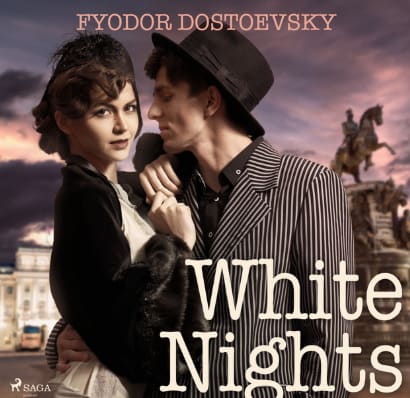Contents
Every day, we meet countless people, receive emails, and attend meetings. But have you ever felt completely alone in this crowd? Those moments when you dream big, but have no one to share them with, shutting yourself away in the chambers of your own mind… In “White Nights“, one of his most poignant works, the great master Dostoevsky holds a mirror up to this modern-day loneliness and our fragile inner world, woven from dreams.
The novel revolves around themes of loneliness, disappointment, hope, and platonic love. In this respect, it recalls Notes from the Underground and The Brothers Karamazov. The narrator is a young man, isolated in his own world, living in dreams, yet equally lonely in real life. This state of loneliness begins to change when he meets a young woman named Nastenka on the street one night. Through these two characters, Dostoevsky masterfully explores human emotional hunger, the search for love, and vulnerability.

Despite its short length, White Nights carries intense emotional depth. The romantic yet melancholic atmosphere of Petersburg is intertwined with the characters’ spiritual worlds. The narrator’s inner dialogue, shifting between dreams and reality, offers the reader both an inner journey and an emotional experience. In this respect, the work foreshadows Dostoyevsky’s later great novels.
This book is not a thick-bound, philosophically profound novel that will tire you; on the contrary, it is a fleeting yet unforgettable story of love and friendship that will touch your heart like spring rain. Let us delve into the magical atmosphere of this short yet intense work and witness the unforgettable encounter of those lonely souls in the crowd over four nights.

Scene and Atmosphere: Magical St. Petersburg Nights
Our story takes place in St. Petersburg, that fairytale city of 19th-century Russia. However, this isn’t a story about the city’s magnificent palaces or bustling streets. Dostoyevsky transports us to the city’s most poetic time: the famous “white nights,” when the sun barely sets in the summer months and the night remains shrouded in twilight. This magical, almost surreal atmosphere establishes the story’s melancholic and dreamlike atmosphere from the very beginning. The city’s canals, bridges, and dimly lit streets become vibrant settings that reflect the characters’ moods.
This atmosphere is not just a backdrop; it also deepens one of the story’s central themes: loneliness. In this period, when everyone flees to their summer cottages and the city empties out, the desolation our hero feels becomes even more pronounced. For a man who sleeps by day and wanders the city’s empty streets at night, consumed by dreams and talking to himself, these bright nights are both a refuge and a prison.
Dostoevsky creates such a strong connection between the city and the character that you sense that even the buildings and streets possess a soul. Our hero greets buildings he recognizes, wondering about their “health.” This is a touching detail that demonstrates the deep connection he cannot establish with people, a connection he forges with inanimate objects, with the city itself. The city is his only friend, his only confidant.

White Nights and St. Petersburg
This dreamlike atmosphere also foreshadows the fleeting yet intense love story to come. During these four nights, where the rules of the real world, time, and space, are virtually suspended, anything is possible. Only in such a magical atmosphere could two strangers suddenly connect with each other’s souls and share their deepest secrets.
In short, when you read White Nights, you don’t just read a story; you also wander the canals alongside the characters in the unique twilight of St. Petersburg, feeling the sweet sadness and hope they share. The atmosphere is as central as the characters themselves.
White Nights Characters: The Dreamer and the Maiden
The novel has two main characters, and these characters represent two distinct aspects we all carry within us.
- Our first and most important character in White Nights novel is our narrator, whose name we never learn, a twenty-six-year-old loner living in his own dream world. He calls himself the Dreamer. Unable to connect with anyone in real life and inept in social interactions, this young man finds happiness and excitement entirely in the stories and fantasies he creates in his own mind. He is both the architect, the hero, and the sole spectator of his own world.
- The Dreamer may seem a pitiful or pathetic figure from the outside. However, Dostoyevsky portrays him with such sincerity and genuineness that, instead of pitying his loneliness, we admire his rich inner world. He is an artist with the soul who escapes the dullness and vulgarity of real life and lives in the palaces of his own mind. For him, dreams are both an escape and a way of being.
- The second character who begins the story and suddenly illuminates the Dreamer’s closed world is seventeen-year-old Nastenka. One night, she finds this young girl crying by the canal, as if she stepped out of a fairy tale. She is pure, innocent, and full of life, yet also deeply sad. Nastenka is a young and inexperienced girl living with her blind grandmother, isolated from the outside world.

Nastenka and The Others
While Nastenka may seem the polar opposite of the Dreamer, she too is a prisoner of sorts. She awaits a young man who moved into their house a year ago as a tenant and with whom she has fallen in love. A year later, he has gone to Moscow to meet them at the same place, and now Nastenka awaits her lover’s arrival on that promised night with hope. Her loneliness is not founded on dreams, but on longing and hope for someone real.
When these two lonely souls meet on that bright St. Petersburg night, they instantly recognize each other’s wounds. Both long to be understood, listened to, and loved. Their relationship begins as a pure friendship, a confidant. They share their life stories, their deepest secrets, and their dreams. These four nights become a dream, forging a bond more real and meaningful than any they have ever experienced.

Summary of the Story: A Four Nights’ Dream
The White Nights novel’s story is divided into five short sections, four nights and one morning. On the first night, our Dreamer, wandering the empty streets of the city as usual, sees a young girl sobbing by a canal. Overcoming all his shyness, he approaches her and rescues her from a drunk who is harassing her. After this meeting, they arrange to meet at the same place the following night. However, Nastenka has one condition: the Dreamer will never fall in love with her. This will be pure friendship.
On the second night, they share their lives. The Dreamer describes his own introverted, dream-filled world, while Nastenka tells the story of her captive life with her grandmother and the story of the tenant she left a year ago, waiting for his return. This night is a night of confidancy, in which the two open their souls to each other and share their deepest secrets. Although the Dreamer has promised not to fall in love with her, he feels his heart drawn to this innocent and vibrant girl.
On the third night, Nastenka’s hopes begin to fade. The man she’s been waiting for hasn’t arrived. She’s filled with disappointment and sadness. The Dreamer consoles her, realizing she can no longer hide her love for him. He promises to deliver a letter to Nastenka about her lover. This is a selfless act, made by the Dreamer for the happiness of the girl he loves, at the expense of his own. He learns the meaning of unrequited love, a feeling so real he’d never even dreamed of experiencing it.

The Magical Fourth Night!
On the fourth and final night, both are certain that the awaited man will not arrive. Nastenka is so grateful for the Dreamer’s love and friendship that she agrees to forget her former love and start a new life with him. Both experience the happiest moment of their lives. At that very moment, something unexpected happens: Nastenka’s lover, whom she’s been waiting for for a year, suddenly appears. After a brief moment of hesitation, Nastenka bids farewell to the Dreamer and runs toward her true love.
The story ends in the final chapter, “Morning.” The Dreamer is alone in her room. In her hand is a short letter of thanks and apology from Nastenka. The four-night dream is over, and she has returned to her old, lonely life. But this time, there’s a difference. Now she has a real memory that has touched her life. She is grateful for even that brief moment of happiness. “My God! A whole moment of happiness! Is that not enough for a whole human life?” The sentence is the summary of the book and Hayalperest’s naive and self-sacrificing spirit.
Conclusion: Why Read White Nights?
White Nights reminds us that the greatest wealth lies in that intimate and profound connection established with the human soul. Life isn’t just about goals to be achieved or successes to be achieved. Sometimes the most unforgettable moments lie in the most unexpected encounters, the fleeting moments. The Dreamer’s story teaches us how nourishing dreams can be, but also how valuable it is to risk touching real life, to show courage, even if only for that fleeting moment of happiness.
The novel’s finale leaves the reader with a sweet sorrow. Despite Nastenka’s love for another person, the narrator considers the brief time spent with her one of the most precious memories of his life. This reflects Dostoyevsky’s subtle perspective on human relationships: Sometimes, even if an encounter doesn’t lead to eternal happiness, it can leave a deep and unforgettable mark on our lives.
Ultimately, the work’s most powerful aspect is its confrontation with the reader’s own loneliness and the world of dreams. Everyone can experience a period of “white nights” in their lives; Periods filled with hope, with a racing heart, but ultimately dominated by reality… Dostoyevsky presents this reality with a touch of romantic melancholy, reminding the reader not to forget the value of dreams.
#whitenightsnovel
#dostoevskynovels
